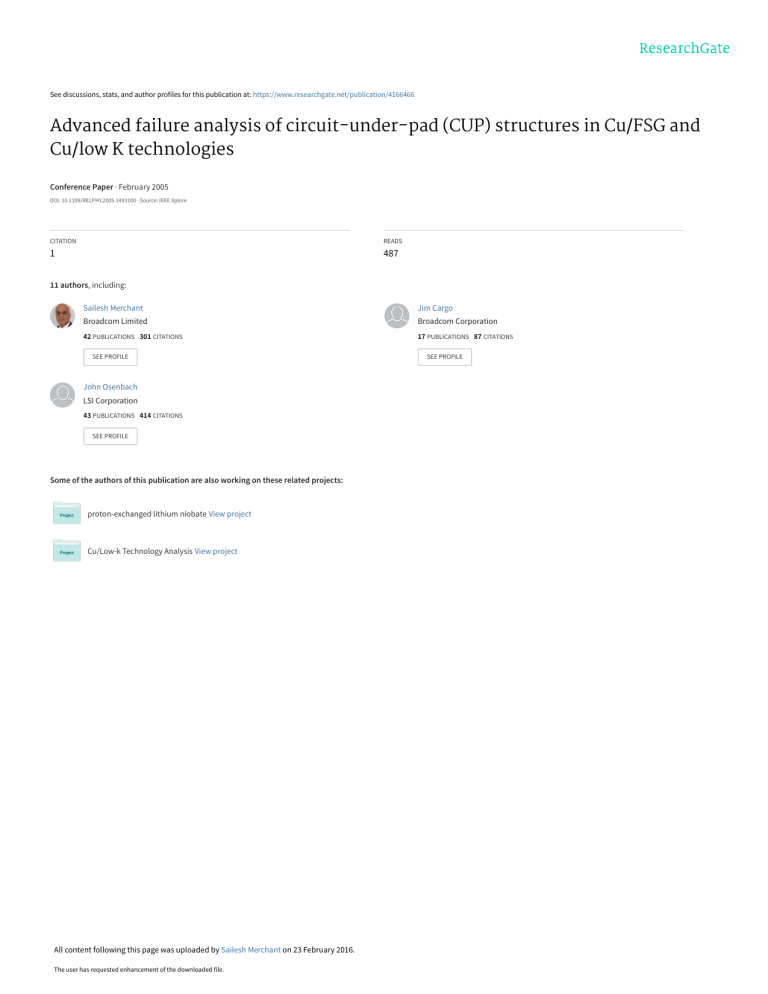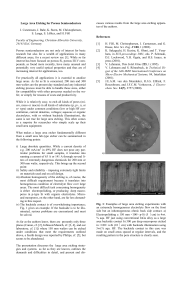
See discussions, stats, and author profiles for this publication at: https://www.researchgate.net/publication/4166466 Advanced failure analysis of circuit-under-pad (CUP) structures in Cu/FSG and Cu/low K technologies Conference Paper · February 2005 DOI: 10.1109/RELPHY.2005.1493100 · Source: IEEE Xplore CITATION READS 1 487 11 authors, including: Sailesh Merchant Jim Cargo Broadcom Limited Broadcom Corporation 42 PUBLICATIONS 301 CITATIONS 17 PUBLICATIONS 87 CITATIONS SEE PROFILE John Osenbach LSI Corporation 43 PUBLICATIONS 414 CITATIONS SEE PROFILE Some of the authors of this publication are also working on these related projects: proton‐exchanged lithium niobate View project Cu/Low-k Technology Analysis View project All content following this page was uploaded by Sailesh Merchant on 23 February 2016. The user has requested enhancement of the downloaded file. SEE PROFILE Advanced Failure Analysis, Failure Modes and Reliability Study on Circuit-Under-Pad (CUP) Structures with Copper Technologies Huixian Wu 1, 2, Vance Archer 1, Sailesh M. Merchant 1, James Cargo 1, Daniel Chesire 1, Joze Antol 1, Rafe Mengel 1, John Osenbach 1, Steve Horvat 1, Carl Peridier 1 , Marvin White 2 1 Agere Systems, Room: 20E-229A, 555 Union Blvd., Allentown, PA 18109 Phone: 610-712-5998, Email: hwu7@agere.com 2 Lehigh University, Dept. of Electrical & Computer Engineering Abstract: In this paper, new failure modes for CUP devices of copper technology, and Failure Analysis (FA) challenges will be presented. Fabrication processing and assembly/package related reliability issues on Cu/low k technology will also be addressed. Failure analysis techniques for CUP devices of copper technology have been developed and will be discussed. Several backside FA deprocessing and crosssection techniques for CUP devices including: reactive ion etching (RIE), parallel polishing, wet chemical etching, chemical mechanical polishing (CMP), Focus Ion Beam (FIB), SEM, TEM and a combination of these techniques will be addressed. Finally some case studies on CUP structures with Cu/FSG, Cu/low k technologies will be presented. 1. Introduction Copper interconnects and low k dielectrics have been introduced in advanced IC technology to reduce the interconnect resistance, improve the resistance to electromigration and reduce RC delay and cross talk effects. The introduction of new materials in integrated circuits makes physical failure analysis more challenging. Moreover, as technology shrinks, defects can be smaller and more subtle, which generates additional challenges for defect localization and physical failure analysis. It is increasingly important to understand new failure modes and reliability issues related to Cu/low k technology and develop FA techniques accordingly. CUP structures with Cu/low k technology are introduced. Some fabrication and assembly/package related reliability issues on Cu/low k technology will be discussed. Some advanced FA techniques will be presented. Conventional front side defect localization in IC devices has become less and less effective with an increase in the number of metallic layers for Photon Emission Microscopy (PEM), as technology continually scales down to subquarter micron. Electrical defect localization in devices with CUP structures, devices with a high number of metallization levels and Flip-Chip Ball Grid Array (FCBGA) packages, can more easily be carried out from the backside of the die. Development of backside failure analysis techniques is increasingly important. In the work, for CUP structures with eight metal layers of Cu/low k technology, front side defect localization is even impossible. Backside failure analysis for CUP structures of Cu/low k technology becomes necessary and critical. Three major steps are involved in the backside FA process: backside sample preparation, backside defect localization, and backside physical analysis. For physical analysis, several backside FA deprocessing techniques for CUP structures will be presented. The deprocessing techniques include wet chemical etching, RIE, parallel polishing, chemical mechanical polishing (CMP), FIB, SEM, TEM and a combination of these techniques. Some characterization results of FA deprocessing will be presented for CUP devices 1 of Cu/low k devices. Finally, some case studies and reliability analysis, and failure mode study will be provided. 2. CUP Structures with Cu/low k Technology Following the fabrication of the semiconductor devices on a wafer, each of the devices (also known as chips or die) is tested for functionality, or the wafers are “sorted”. Electrical probes from a tester contact bonding pads formed on each of the devices to determine if individual devices are functional. After electrical testing, the wafer is cut and the devices are separated from one another. The devices are then assembled onto a substrate using procedures known as die attach or die bonding. Subsequent to the attachment of the devices to package substrates, electrical connections are made between the bonding pads on the devices and the electrical leads on the package. The electrical connections are made using different techniques including wire bonding, flip-chip bonding and tape-automated bonding. At least with respect to wire bonding, a bonding pad is subjected to a force applied directly to the bond that may damage underlying layers, materials, or components of a device. After the die attachment and wire bonding operations are completed, the device is then “packaged” into a plastic molded package or a ceramic package, depending upon the die size, package application and end-use. These devices are subjected to thermal and mechanical stresses during electrical testing, during wafer test and subsequent assembly procedures. Damage to the device may be caused during electrical testing, when the test probes are pressed against the bonding pad. During the probing operation, bond pad metal may be deformed, thus preventing a reliable electrical connection during subsequent wire bonding between the bond pad and the package pad. Moreover, the nature of the bond may be mechanically and metallurgically weak, leading to wire lift-off or a “non-stick” (no adherence) situation. This problem is exacerbated by the ever decreasing sizes of bond pad on which smaller wire bonds are formed, leaving very small regions where a sound wire bond is possible. Furthermore, during the wire bond operations, dielectric cracking can occur and cracks can propagate through the layers to device components, which may be damaged. For reasons outlined above, the industry has opted to preclude the use of the area under the bond pads for device layout, thereby decreasing the efficiency of substrate utilization for active circuitry. Input and output buffers are thus located on the periphery of the device and between bond pads to avoid placement of such components under the bond pad. Therefore, the spacing between the bond pads must be increased to accommodate these buffers or other similar devices. In order to save valuable space on the device, thereby decreasing the overall chip dimensions, Agere Systems has begun placing active circuitry underneath the pads [1]. The circuit under pad (CUP) concept uses a variety of support structures that contain metals, dielectrics and combinations thereof. These CUP bonding pad support structures are designed to protect device components that are disposed within the device directly under the pad in conjunction with minimizing the damage caused by probe testing and subsequent assembly. Such a support structure will also inhibit bond pad peeling that may result from underlying layer damage. In this study tester devices, containing a variety of CUP support structure designs and configurations, were fabricated to better understand the interactions between probe testing, wire bonding and subsequent assembly operations on active circuitry under the pad. A series of damage and crack detection circuits were specifically designed and placed under the bond pads to quantify this damage. Many of the test structures were fabricated without any protection from electrical over-stress (EOS) or electro-static discharge (ESD). This study reports the effects of electrical over-stress on the behavior of these unique test structures and methods of analyzing failures of these test structures under electrical over-stress. 2 After subjecting the test devices to routine sort and assembly processes, typical accelerated reliability tests were performed to assess the degree of damage, if any, from these operations to the integrity of the specially designed damage testers placed underneath the pads. Moreover, the performance of conventional device circuitry, underneath the CUP support structures, was also determined and compared with devices fabricated without CUP support structures. This report outlines the various techniques used to determine the degree of mechanical and metallurgical damage (if any) created to devices fabricated with multilevel copper/low-k interconnects at the 130nm technology node. 3. Process and Packaging Effects on Reliability of CUP Structures with Cu/low k Technology A. Process Issues: Copper CMP process has a critical effect on the low k dielectric delamination. Low polishing shear force is preferred. Shear force depends not only on process parameters, but also on pad materials, slurry type, and the accumulation of polish by-products [2]. CMP solution plays an important role on the rate of chemically assisted crack growth in low k dielectric [3]. Adhesion energies of Cu – low k dielectric interfaces measured with the technique of four-point bending, show a correlation to chemical mechanical polish result. The interfaces with adhesion energy below a critical value exhibit delamination and cracking [4]. The etching and CMP processes have a major influence on the dielectric breakdown. The composition of the dielectric diffusion barrier and pretreatment of the low k surface also affect the integrity of the barrier/low-k interface [5] [6]. Slight changes in the interfacial chemistry result in dramatic change in interface adhesion [6]. Barrier/dielectric interface with copper technology has found to be susceptible to subcritical debonding similar to stress-corrosion cracking. It is also found moisture has a larger effect on reducing the interface adhesion than temperature [7]. Due to weak mechanical properties and weak adhesion of low k material, cracks and interface delamination is contributing to inter-level dielectric (ILD) failures. The primary failure mode in structures with high breakdown field was mechanical cracking of the dielectric barrier or delamination at the barrier/ILD interface. The type of the failure mode was strongly related to processing conditions and is not necessary a function of stress condition during the test [5]. B. Packaging Issues Packaging assembly can significantly impact wafer-level reliability causing interfacial delamination, which is a serious reliability concern for Cu/low k technology [8]. Key assembly processes that impact interfacial reliability include: wafer dicing, wire bonding, flip chip bumping, molding, or under-filling [9]. At package level, the crack driving force is not only residual stresses and thermal mismatch stresses, but also the global thermal mismatch of the package [10]. Delamination and cracking can occur as mechanical and thermal stress are introduced during fabrication processing such as CMP, pretreatment, high temperature curing steps, and so on. Delamination and cracking can also occur during assembly/package processing due to the large difference in thermal expansion coefficients between the die and package substrates. Defects or failures can be exaggerated during reliability stress tests (HTOB, HTS, THB, TC). The effect of packaging on the energy release rate driving interface delamination and its impact on reliability for Cu/low k. Interface delamination is commonly observed in low k 3 interconnects after assembling the die into a flipchip package [11]. polishing, wet chemical etching, CMP and RIE have been developed for Cu/low k technology. Dicing or sawing is the first step in the packaging process. Low k material has weak mechanical properties, low adhesion strength, which introduce more challenges on packaging and assembly processing. Good seal ring design is important in protecting the dies from the sawing process [12]. Traditional front side defect localization is not effective for CUP structures due to the gold balls on top of bond pads blocking the thermal and light emission from defect sites. Backside defect localization from backside of the die is necessary for CUP structures. Wire bonding in Cu/low k technology presents challenges. A major problem encountered in bonding to Cu/low k chips results from the oxidation of the copper during handling, wafer sawing, die attaching curing and thermo-sonic bonding [13]. C. Reliability Accelerated Testing This section will be discussed late. 4. Failure Modes and FA Challenges for CUP Structures of Cu/low k Technology FA challenges will result from new failure modes and reliability issues associated with the integration of Cu and low k dielectrics. CUP structure brings additional challenges for electrical defect localization and physical failure analysis: Deprocessing copper and low k materials present challenges. Delayering copper presents several challenges, such as global uniformity problems, dishing of metal interconnect, copper smearing, and erosion of copper and dielectrics. For delayering low k dielectrics, parallel polishing has limitations due to its non-uniform process and low removal rate. The conventional wet chemicals used for ILD etching are not suitable for some low k dielectrics. RIE may be an alternative due to certain advantages. However, there are still some challenges for RIE of low k materials including etch selectivity, RIE grass, surface roughness, and optimization of the process parameters. In this work, several deprocessing techniques such as parallel More challenges may also be introduced during front side physical deprocessing on CUP devices. Traditional wet chemicals used for gold ball removal don’t work for CUP devices with Cu/low k technologies due to the wet chemicals etching away copper and breaking through the barrier layers. Parallel polishing of gold balls may introduce mechanical stress, causing cracks or delamination, which is also not a proper method. Backside physical analysis and deprocessing may be an alternative, especially for CUP devices. 5. Failure Analysis Development for CUP Devices A. Backside sample Preparation for CUP devices A combination of mechanical milling (ChipUnzip TM) and RIE techniques has been employed for silicon thinning, which is a critical step in the backside sample preparation process [14]. In this process, RIE can be used for final silicon thinning after mechanical milling to achieve more precise control of thickness of the remaining silicon die while still preserving the electrical integrity of the device. Figure 1 shows a low power optical image of the backside PBGA package during the backside sample preparation process. The thickness of the remaining silicon material is approximately 100 microns. 4 Figure 1. Low power image of package after backside silicon thinning and final polishing B. Backside Defect Localization for CUP devices Several backside defect localization techniques and tools have been used in the industry, such as Light-Induced Voltage Alteration (LIVA), Thermally-Induced Voltage Alteration (TIVA), Optical Beam Induced Resistance Change (OBIRCH), Picosecond Imaging Circuit Analysis (PICA), Laser Voltage Probing (LVP), Fluorescent Microthermal Imaging (FMI), and Photo Emission Microscopy (PEM). In this work, backside FMI techniques were performed to localize the defect site. Device was analyzed under FMI through the backside during unpowered curve trace. Thermal emissions were detected at the failed pin during pin-to-pin curve tracing of the device. No light emission was detected. The same thermal emission was also detectable using Liquid crystal analysis through the backside. Figure 2 show backside FMI images of the thermal emission for defect localization. Figure 2 FMI images of the thermal emission for defect localization C. Backside Physical Analysis After backside sample preparation and backside defect localization, backside physical failure analysis becomes increasingly critical to find the root cause of the failure. Silicon removal, expose active circuitry from Backside In certain package types other than flip-chip BGA packages, after the backside sample preparation process, there is a cavity in the backside of the package containing the die. Deprocessing the whole package from the backside is time consuming. Moreover, some artifacts and defects could be introduced during deprocessing of the entire package. There are several ways to separate the die from the rest of the package. One way is mechanical sawing, and the other is wet chemical etching [15]. Combination of RIE and parallel polishing can be used to remove the silicon material until the remaining silicon thickness was approximately five microns. RIE characterization of the silicon 5 substrate for backside FA has been performed in our previous work [14]. TMAH wet chemical etching was used to selectively remove silicon material over gate oxide due to its high Si/SiO2 etch selectivity. The advantages of TMAH over mechanical polishing for removing the silicon substrate are as follows: removing silicon without damage to gate oxide, better uniformity across the die, and better control of backside deprocessing. The etch rate of silicon, gate oxide, and Si/SiO2 etch selectivity have been characterized at different temperatures and at different TMAH concentrations in our previous work [15]. Si/SiO2 etching selectivity decreases with an increase in temperature. In this work, 20% TMAH was used to remove silicon material at temperature of 70 degree C. Backside physical site analysis – gate level analysis Gate level failure modes could be breakdown of the gate dielectrics, soft breakdown (SBD), stress induced leakage current (SILC), direct tunneling, hot carrier injection (HCI), trap assisted tunneling (TAP), negative bias temperature instability (NBTI), and interface instability. The ability to perform physical FA at the gate level has become increasingly important with increased potential gate level defects, such as soft breakdown of ultra thin gate oxide, SILC, TAT and so on. In this paper, Backside gate level deprocessing techniques will be presented. To detect physical gate defects and study gate dielectric integrity, Silicon etch process to expose the gate dielectric is important and critical. Figure 3 shows the SEM image at the gate level from backside of the die. Figure 3. SEM image at the gate level More will be discussed later on. Backside physical site analysis – combination of CMP and RIE for metal level deprocessing A combination of CMP and RIE was used to deprocess the device layer and layer at the metallization levels during backside FA. The CMP method used for backside FA is similar to the one for front-side FA. Deprocessing of copper by CMP presents several challenges to the FA analyst. Especially for CUP structure, which is in the edge or corner of the die, more challenges are introduced during the deprocessing and physical analysis of CUP structures. Patterned wafers have been used for characterization of the CMP process in our previous work [16]. The polishing parameters investigated include slurry chemistry, polishing pad type, pressure, and pad rotation speed. We found that multi-step CMP techniques with different polishing conditions can be extremely useful for deprocessing copper layers. Lower pressure and lower pad rotation speed are used in the final step to avoid over-polish of copper. The characterization of RIE process of low k dielectrics has been performed in our previous work [17]. With the optimization of the RIE process, high etch selectivity, low damage, and a clean surface free of RIE grass can be achieved. Figure 4 shows the SEM image of exposed 6 comb/meander structure by using CMP of copper and RIE of low k material. Figure 5. Backside optical image – M5 layer Figure 4. SEM image of exposed comb/meander structure underneath the bond pad Backside Cross Section Analysis- Focus Ion Beam (FIB) FIB cross-section analysis can used to study the integrity of the copper/barrier/low k interface. SEM analysis was then performed at the damaged area. A dielectric crack, copper migration along the crack and thermally induced damage in dielectric was observed. The damage appeared to be caused by electrical overstress, resulting in thermal effects. Figure 6. Backside optical image – M6 layer SEM analysis of the observed anomaly was performed at M6 layer. Metal cracks were observed, which is shown in Figure 7 and 8. 6. Failure Analysis Case Studies on CUP Devices with Cu/low k Technology Case Study 1: An anomaly was observed at thermal emission site when deprocessing the device down to M5 layer and M6 layer, which are shown in Figure 5 and Figure 6. 7 Figure 7. SEM image of the observed anomaly – metal cracks at M6 layer Figure10. Backside optical image – M5 layer Figure 8. SEM image of the observed anomaly – thermal damage at M7 layer Case Study 2: (CMP & RIE) In this case, a combination of CMP and wet chemical etching was performed to deprocess the device from backside of die. Figure 9 and Figure 10 showed an optical image of an anomaly at M4 and M5 layer, respectively. Case Study 3: (CMP & Wet chemical Etching) In this case, a combination of CMP and wet chemical etching was performed to deprocess the device from backside of die layer by layer. Figure 11 shows the optical image of the observed defects. Figure 12 shows the SEM image of the defect after exposed M5 copper runner. Figure11. Backside optical image – M5 layer Figure 9. Backside optical image – M4 layer 8 Figure12. SEM image of M5 layer Figure 13. Optical image of the defects at M4, M5 layers Figure 11 and 12 show the anomalies at the edge of the meander/comb structure. Dielectric cracks, copper extrusion, copper voids were observed at the damaged areas, which were believed to be caused by electrical overstress. Case Study 4: (CMP & FIB) During backside physical failure analysis, a combination of CMP and RIE was used to deprocess the device layer and layer down to Metal 5 (M5) layer. High power optical inspection was performed and a damaged area was observed at edge of the meander structure at M5 layer, shown in Figure 13. Further FIB cross-section analysis was performed at the damaged area. SEM analysis was then performed at the damaged area. A dielectric crack, copper migration along the crack and thermally induced damage in dielectric was observed in Figure 14 and 15. The damage appeared to be caused by electrical overstress induced thermal effects. Figure 14. FIB image of the defects 9 7. Conclusion Figure 15. FIB image of the defects Case Study 5: - Study of gate level defect To detect physical gate defects and study gate dielectric integrity, Silicon etch process to expose the gate dielectric is important and critical. Figure 16. SEM image at the gate level Reliability analysis and technical discussion on failure modes on CUP structures This section will be provided later CUP structures have been developed and introduced. Various process and package related reliability issues on Cu/low k technology have been discussed. Several FA techniques including deprocessing and cross section techniques for CUP structures of Cu/low k technology have been presented: reactive ion etching (RIE), parallel polishing, chemical mechanical polishing (CMP), FIB cross-section and combinations of these techniques. We found the combination of RIE and CMP techniques works well for deprocessing copper and low k ILD layers. Various FA challenges for CUP structures of Cu/low k technology were also addressed. Finally some FA case studies were discussed. Reference: [1] S. Chittipeddi et al., US Patent 5,751,065. [2] Stan Tsai and et al., pp. 102-104, 2002 IEEE [3] Eric P. Guyer and R.H. Dauskardt, pp. 89-91, 2003 IEEE [4] T. Scherban and et al., pp. 257-259, 2001 IEEE [5] Glenn B. Alers, K. Jow and et al., pp. 148152, IEEE Transactions on Device and materials Reliability, Vol. 4, No. 2, June 2004 [6] M. Lane, N. Krishna, I. Hashim, and R.H. Dauskardt, J. Mater. Res., Vol. 15, No. 1, pp. 203-211, 2000 [7] M. Lane, X. Liu, and T.M. Shaw, IEEE Transactions on Device and Materials Reliability, Vol. 4, No. 2, pp. 142-147, 2004 [8] Guotao Wang, Steven Groothuis, and Paul S. Ho, pp. 28-30, 2004 IEEE [9] Cheryl D. Hartfield, Ennis T. Ogawa and et al., pp. 1-15, IEEE Transactions on Device and materials Reliability, Vol. 4, No. 2, June 2004 [10] Lei Mercado, Cindy Goldberg, and ShunMeen Kuo, pp. 119-121, 2002 IEEE [11] Guotao Wang, Steven Groothuis, and Paul S. Ho, pp. 727-732, 2003 Electronic Components and Technology Conference [12] Hanxie Zhao and Dianne Shi, pp. 401-407, 2003 IEEE Int’l Electronics Manufacturing Technology Symposium 10 [13] George G. Harman and Christian E. Johnson, pp. 677-683, IEEE Transactions on Component and packageing Technologies, Vol. 25, No. 4, Dec. 2002 [14] Huixian Wu and James Cargo, “Characterization of reactive ion etching of silicon substrate for backside failure mode analysis”, ISTFA 2002 [15] Huixian Wu, James Cargo, “Backside failure analysis and case studies for Cu/low k technology”, 2004 IPFA [16] Huixian Wu, James Cargo, Barry Dutt and et al., “Interconnect and Gate Level Delayering Techniques for Cu/Low k Technology Failure Analysis”, ISTFA 2003 [17] Huixian Wu, James Cargo, Carl Peridier and Joe Serpiello, “Reliability issues and advanced failure analysis deprocessing techniques for copper/low k technology”, pp. 536-544, 2003 IRPS 11 View publication stats



